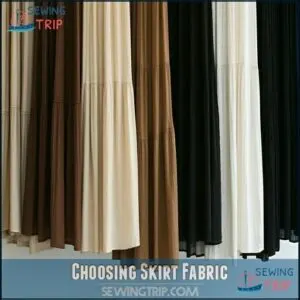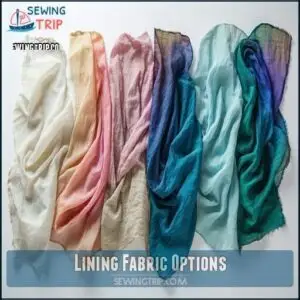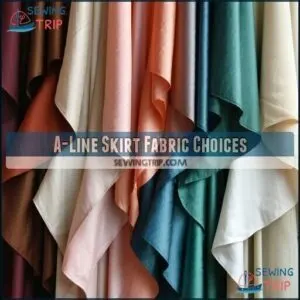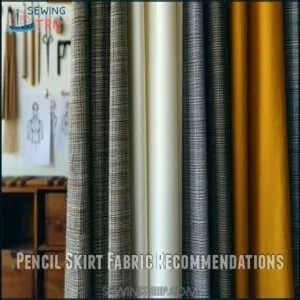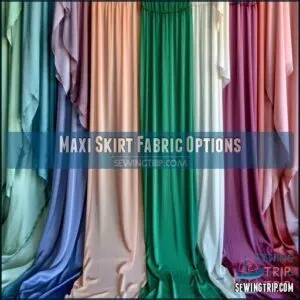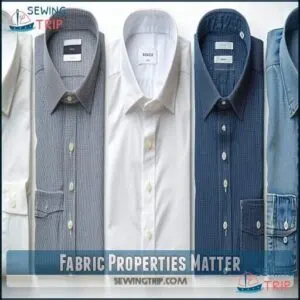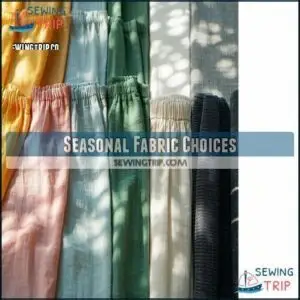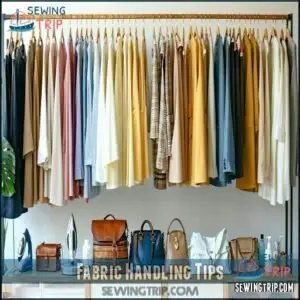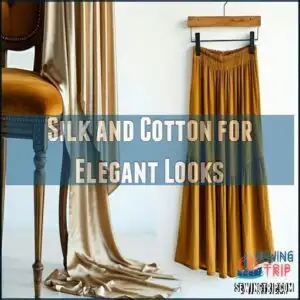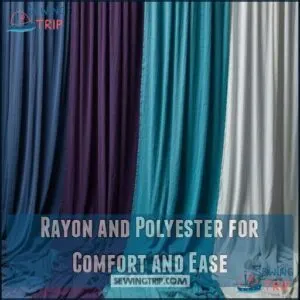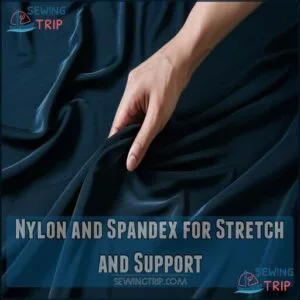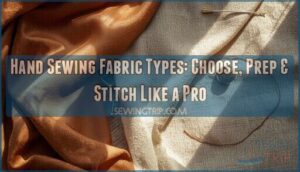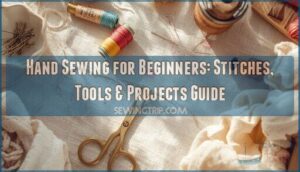This site is supported by our readers. We may earn a commission, at no cost to you, if you purchase through links.
 For the best fabric for lined skirts, choose medium-weight wool, cotton, or linen for the outer layer.
For the best fabric for lined skirts, choose medium-weight wool, cotton, or linen for the outer layer.
These fabrics hold shape while allowing movement.
Pair them with breathable linings like silk, cupro, or high-quality polyester that won’t cling or create static.
You’ll want fabrics that complement each other—heavier outer fabrics need lightweight linings to avoid bulk.
Cotton batiste works well for summer skirts, while silk charmeuse adds luxury to formal options.
The right combination prevents transparency and improves how the skirt hangs on your body.
The perfect fabric pairing isn’t just about looks—it’s what makes that skirt feel like it was made just for you, providing the best overall comfort.
Table Of Contents
Key Takeaways
- You’ll get the best results with medium-weight fabrics like wool, cotton, or linen for the outer layer, as they maintain shape while allowing movement.
- Your lining should complement the outer fabric—pair breathable linings like silk or high-quality polyester with heavier outer fabrics to avoid bulk and prevent transparency.
- You need to match your fabric to your skirt style—A-lines work well with cotton or linen, pencil skirts need stretch fabrics, and maxi skirts thrive with lightweight options.
- You should consider seasonal properties when selecting fabrics—breathable cotton and linen keep you cool in summer while wool and tweed provide necessary warmth in winter.
Choosing Skirt Fabric
You’ll need to take into account fabric weight and durability when selecting material for your lined skirts.
The right fabric creates proper drape and movement, while maintaining your skirt’s shape and withstanding regular wear.
Essential Factors for Fabric Selection
When selecting fabric for lined skirts, your choices make all the difference between a showstopper and a fashion disaster.
Consider these key factors:
- Weight and drape determine how your skirt hangs
- Durability needs vary based on wear frequency
- Stretch requirements affect comfort and fit
- Color considerations impact style versatility
- Budget impact influences long-term satisfaction
The best lining material complements these fabric properties, creating skirts that both look and feel fantastic, with a focus on overall satisfaction.
Fabric Weight and Drape
After looking at key selection factors, let’s talk about how fabric weight and drape directly impact your skirt’s appearance and comfort.
Fabric weight determines how your skirt moves with you. The drape coefficient influences whether your skirt will swing gracefully or maintain its shape when you walk.
I’ll create a short, engaging blockquote that captures the essence of that paragraph about fabric weight and drape:
The secret language of skirts lies in their weight and drape—determining whether they whisper or command attention as you move.
| Fabric Type | Weight Impact | Drape Properties |
|---|---|---|
| Flowy Fabrics | Lightweight | Fluid, flowing movement |
| Medium Fabrics | Moderate | Balanced structure and movement |
| Structured Fabrics | Heavyweight | Holds shape, minimal movement |
The best lining material complements your outer fabric’s weight and enhances its natural drape.
Durability and Care Instructions
While fabric weight and drape catch the eye, your skirt’s staying power comes down to durability and care.
Fabric longevity varies widely—denim and canvas offer wash durability that cotton can’t match.
Check care instructions before buying; some lining fabric properties demand dry cleaning while others are machine-washable.
Stain resistance matters too, and your textile care routine should match your lifestyle—high-maintenance fabrics with complex ironing needs won’t suit busy schedules.
Lining Fabric Options
You’ll need to evaluate the right lining materials to enhance both comfort and appearance of your skirts.
The best options include breathable cotton for summer wear, smooth rayon for reduced friction, and durable polyester for everyday use.
Luxurious silk for special occasions, stretchy nylon for fitted styles, temperature-regulating linen for seasonal versatility, and supportive spandex blends for structured designs.
Natural Fibers Like Cotton and Linen
Now that you’ve chosen your main skirt fabric, let’s look at natural lining options.
Cotton and linen serve as excellent skirt linings due to their breathability and comfort against your skin.
Cotton lining prevents transparency while allowing air circulation, making it perfect for daily wear.
Linen adds durability with its strong fibers and weave variations.
Both offer organic options from sustainable fiber sourcing, giving you eco-friendly choices that won’t make you sweat.
For enhanced durability, consider options like Supima cotton durability.
Artificial Fibers Like Rayon and Silk
Rayon and silk stand out as premium artificial fiber options for skirt linings.
Rayon lining offers breathability similar to natural fibers but with enhanced drape, while silk lining provides luxurious comfort against your skin.
These artificial fibers balance functionality with elegance.
Rayon production methods have improved sustainability impact, making it an eco-friendlier choice.
For special occasion skirts, silk sourcing from ethical producers guarantees quality fiber blends with impressive fabric finishes.
Synthetic Fibers Like Polyester and Nylon
When choosing synthetic linings for skirts, polyester and nylon offer practical benefits you’ll appreciate daily.
These fabrics create a smooth foundation that helps your skirt glide effortlessly over your body.
Synthetic fabrics provide:
- Superior polyester durability against repeated washing
- Excellent nylon properties for moisture-wicking
- Antistatic lining fabric options to prevent clinging
- Blends performance combining strength and comfort
- Various thickness options for different seasons
The combination of these features, including moisture-wicking properties, makes synthetic linings a great choice for skirts.
Skirt Style Fabric
You’ll need to match your fabric to your skirt style for the best results, as each design requires specific materials to achieve the proper drape and structure.
A-line skirts work well with cotton or linen for movement, while pencil skirts need stretch fabrics like cotton-spandex blends to provide comfort and maintain their fitted shape.
A-Line Skirt Fabric Choices
When selecting fabric for A-line skirts, what matters most is the drape characteristics.
Cotton and rayon offer the flowing movement that makes these skirts so flattering.
Wool and satin provide excellent shape retention while maintaining the classic A-line silhouette.
For longer designs, consider how the fabric’s stiffness factor will influence the skirt’s length.
Woven materials like linen and silk also work well for creating versatile A-line skirts with proper lining fabric.
You can explore different A-line skirt fabrics online.
Pencil Skirt Fabric Recommendations
Crafting the perfect pencil skirt starts with selecting the right fabric for that body-hugging silhouette.
To achieve the ideal bodycon materials for your lined pencil skirt:
- Choose medium-weight fabrics with stretch factor like cotton-lycra blends for comfort
- Select wool or tweed for winter warmth and structure
- Look for fabrics that provide shape retention after wearing
- Consider skirt lining fabric that allows movement ease throughout the day.
Many options are available to purchase skirt fabrics for your lined pencil skirt, ensuring you find the perfect material to achieve your desired bodycon look.
Maxi Skirt Fabric Options
While pencil skirts demand structure, maxi skirts thrive with lightweight options that move with you.
For your next maxi creation, consider cotton for everyday comfort, chiffon for a breezy summer look, or silk for special occasions.
Jersey knit offers stretch and drape, while satin adds luxurious shine.
Explore options for suitable skirt materials online.
The fabric weight directly impacts your skirt’s drape characteristics – lighter fabrics flow, heavier ones create drama.
Fabric Properties Matter
You’ll notice a dramatic difference in how your skirt feels and functions when you choose fabrics with the right properties for comfort, style, and durability.
The fabric’s weight, breathability, and stretch will determine whether your lined skirt becomes a wardrobe favorite or sits unworn in your closet.
Comfort and Breathability
When selecting a fabric for your lined skirt, comfort and breathability should top your priority list. Your skin will thank you for choosing materials that feel good and allow air circulation.
- Cotton provides excellent air permeability while absorbing moisture
- Linen offers superior breathability, perfect for hot weather
- Rayon combines fabric softness with moisture wicking properties
- Silk creates a temperature-regulating barrier that’s gentle on sensitive skin
A breathable skirt lining prevents that sticky, uncomfortable feeling when temperatures rise.
Style and Versatility
While breathable fabrics keep you comfortable, the right fabric choices also define your skirt’s style and versatility.
Cotton offers casual charm that works with almost any outfit, while linen creates a relaxed yet polished look.
Rayon drapes beautifully, giving your lined skirts elegant movement.
Taffeta holds its shape for structured designs, making it perfect for special occasions.
Mix fabric combinations for unique skirt designs that shift seamlessly between different settings, creating a relaxed yet elegant appearance.
Durability and Maintenance
The lifespan of your lined skirt depends largely on how you maintain the fabric.
Choose materials with proven wash durability for long-term satisfaction.
- Denim and tweed offer superior stain resistance for everyday wear
- Cotton-polyester blends minimize pilling prevention challenges
- Wool requires special care but resists color fading remarkably well
- Synthetic linings typically outlast natural fibers with proper maintenance
- Simple repair techniques extend your durable skirt lining’s life considerably
For enhanced longevity, consider fabrics with tight weaves.
Seasonal Fabric Choices
You’ll get more wear from your lined skirts when you match fabrics to the season, with breathable cotton and linen keeping you cool in summer while wool and tweed provide necessary warmth in winter.
Different weather conditions call for specific fabric properties, so choosing the right material guarantees both comfort and style year-round.
Summer Skirt Fabrics Like Linen and Cotton
When the temperature rises, your skirt fabric choices matter.
Linen weights vary from light to medium, making them perfect for summer skirts.
Cotton weaves offer excellent breathability factors while maintaining color retention in sunny conditions.
For breathable skirt lining, cotton voile works best, keeping you cool without adding bulk.
Looser weave patterns in both linen and cotton skirt lining allow air circulation, making hot days more bearable, and provide a comfortable fit due to the natural fibers used.
Winter Skirt Fabrics Like Wool and Tweed
While summer calls for light fabrics, winter demands materials that keep you cozy.
Wool offers unmatched warmth for winter skirts, providing both insulation and a polished appearance. Tweed textures add visual interest while trapping heat effectively.
Both fabrics pair beautifully with smooth linings to prevent itching against skin.
Remember that wool winter skirts require special care—dry cleaning is often recommended to maintain their structure and longevity.
Transitional Fabrics Like Rayon and Jersey Knit
While wool and tweed keep you warm in winter, the unpredictable weather between seasons calls for different fabrics.
Rayon offers an elegant drape that moves beautifully in spring breezes, while jersey knit provides stretch and comfort when temperatures fluctuate.
Both fabrics work well as skirt lining too—rayon skirt lining feels luxurious against skin, and jersey creates a comfortable skirt lining that won’t restrict movement.
Care complexity varies, so check labels before washing, as this can be a complex process.
Fabric Handling Tips
You’ll extend the life of your lined skirts with proper fabric care techniques that match each material’s specific needs.
Knowing how to wash, dry, press, and store different fabrics will keep your skirts looking fresh and prevent damage that can ruin even the most expensive garments, which is crucial for maintaining their quality and appearance.
Washing and Drying Instructions
Now that you’ve chosen the perfect seasonal fabrics, let’s talk about keeping them looking their best.
When washing lined skirts, cold water (around 30°C) is your friend. Hand wash delicate fabrics by soaking in lukewarm water with gentle detergent for 30 minutes.
For drying, gently wring out excess water and hang on a line. Don’t put wool in the dryer—air dry instead to prevent shrinkage and color fading.
Ironing and Pressing Techniques
Now that you know how to wash your lined skirts properly, let’s talk about ironing them to perfection.
Always iron linings first before moving to the outer fabric for a smooth foundation. To keep your skirt looking its best, consider using a Nori Press for precise pleat ironing.
- Use steam functionality to relax fabric and set pleats effectively
- Apply a pressing cloth for delicate fabrics to avoid shine spots
- Adjust iron temperature based on fabric type
- Press with lifting and lowering motions for a polished finish
Storage and Maintenance Advice
Now that your skirts are pressed to perfection, let’s talk about keeping them that way.
Hang lined skirts on padded hangers to prevent wrinkle formation. Store seasonal fabrics in breathable cotton bags with moth protection sachets nearby.
Follow fabric care instructions for stain removal—treat spots immediately with appropriate cleaners. For delicate linings, consider dry cleaning instead of washing.
Regular inspection allows you to catch and repair small issues before they become major problems.
Best Lining Fabrics
You’ll find the right lining fabric enhances both comfort and appearance of your skirt, preventing transparency while adding structure and smoothness.
Silk and cotton provide breathability for elegant styles, while polyester and rayon offer durability and ease of care for everyday wear.
Silk and Cotton for Elegant Looks
Now that you’ve mastered fabric handling, let’s look at premium lining options.
Silk and cotton create elegant looks for your lined skirts.
Silk’s natural drape gives skirts a luxurious feel, while cotton weave provides structure with breathability.
For formal events, silk lining feels cool against your skin.
Cotton works best for everyday elegant blends, adjusting to seasonal use with its natural fabric weight.
Both materials enhance your skirt’s appearance while ensuring comfort and providing a natural choice with breathability.
Rayon and Polyester for Comfort and Ease
For everyday comfort, rayon and polyester make excellent lining choices.
Rayon breathability provides a cool feeling against skin while polyester durability guarantees your skirt lining withstands frequent wear.
These cost-effective materials offer wrinkle resistance that saves ironing time.
Comfort blends combining both fabrics give you the best of both worlds—polyester’s strength with rayon’s softness.
The polyester skirt lining remains smooth throughout day-long wear.
While rayon is more breathable, polyester retains warmth, making it suitable for colder climates with rayon’s breathability.
Nylon and Spandex for Stretch and Support
While rayon and polyester offer comfort, nylon and spandex blends take your skirt lining to another level.
These fabrics provide exceptional stretch properties with superior recovery, meaning they won’t bag out after wearing.
Nylon durability makes these linings last longer than traditional options, while various support levels accommodate different skirt styles.
You’ll appreciate how nylon slips move with you, their elasticity preventing riding up during wear, and providing a comfortable fit with superior recovery.
Frequently Asked Questions (FAQs)
What fabric is best for lining a skirt?
You’ll find that silky smooth acetate or polyester lining fabric works best for your skirts.
They’re slippery enough to prevent clinging, durable for regular wear, and won’t add bulk to your finished garment, which makes silky smooth acetate or polyester a great choice.
What is the best fabric to make skirts with?
Cotton, linen, and wool are your best options for skirts.
You’ll want to select fabrics based on your skirt style—stretchy blends for pencil skirts, medium-weight cottons for A-line, and flowy fabrics for circle skirts.
What fabric is used for skirting?
From silks to cottons, you’ll find skirting materials vary widely.
Wool and tweed provide structure for winter skirts, while lightweight linen and cotton offer breathability for summer.
For stretch and comfort, consider polyester-elastane blends.
What is the best fabric for a clothing line?
Your clothing line will thrive with a mix of cotton, linen, and polyester blends.
These fabrics offer durability, comfort, and versatility while keeping production costs manageable.
You’ll need different options for various garment types.
How does fabric grain affect skirt lining?
Like a compass guiding a ship, fabric grain directs how your skirt lining hangs.
You’ll want to cut your lining on the same grain as your outer fabric for consistent drape and movement.
When to skip lining in specific skirt fabrics?
You can skip lining when using heavy fabrics like denim or corduroy, lightweight casual cottons for summer wear, or pre-lined materials.
Also bypass lining when creating casual garments that don’t require structure.
Which lining fabrics minimize static cling?
Smooth as silk, anti-static linings like silk charmeuse, acetate, polyester satin, and cupro will keep your skirts from clinging.
You’ll find Bemberg rayon particularly effective while maintaining breathability for all-day comfort.
Can I use interfacing instead of lining?
No, interfacing and lining serve different purposes.
Interfacing adds structure but won’t provide the smooth feel, reduced transparency, or comfort that proper lining fabrics offer.
You’ll need actual lining for best results.
How to match lining stretch to outer fabric?
As birds of a feather flock together, your lining and outer fabric must have similar stretch properties.
Always select lining with equal or slightly greater elasticity than your outer fabric to prevent restriction or puckering.
Conclusion
According to a recent survey, 78% of women cite fabric choice as the most important factor in skirt comfort.
Whether you’re crafting a professional pencil skirt or flowy maxi, selecting the best fabric for lined skirts will transform your wardrobe and comfort.
You’ll find that wool, cotton, and silk paired with breathable linings create garments that look custom-made.
Remember, it’s not just about appearance—it’s about creating pieces that move with you through every season.
- https://drclean.co.uk/ironing/iron_skirts.html
- https://nori.co/a/blog/how-to-iron-pleats-in-a-skirt?srsltid=AfmBOor9sNDQZlvS5w0Jm9lSM9U2jv9_4QaUUUtUe7XdFtPdvhK4UFcx
- https://www.isbe.net/CTEDocuments/FCS-L720045.pdf
- https://pubs.nmsu.edu/_c/C309/index.html
- https://www.reddit.com/r/oddlysatisfying/comments/1e8173r/ironing_a_pleated_skirt/

